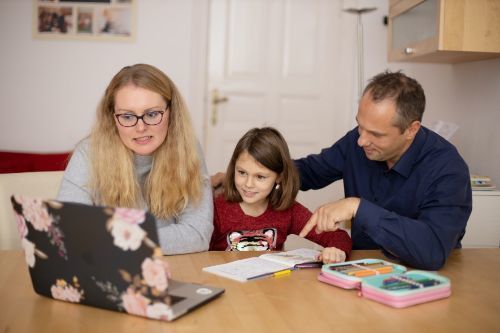School Age and The Individualized Educational Program
A federal law requires that an Individualized Educational Program (IEP), be developed for each child who is identified as having special needs.
It is important to note that a hearing loss does not, in and of itself, qualify a school-age child for special education services. Rather, the child who is deaf or hard of hearing must have an educational deficit as a result of the hearing loss and require specially designed instruction to meet his/her unique needs. Eligibility for special education will be determined by evaluation results gathered by a multidisciplinary team.
Once special education eligibility has been determined, a meeting will be convened to develop the IEP. The IEP allows the teachers to zero in on exactly what your child needs. Developing an IEP is complicated and not foolproof. It is intended that parents and professionals work together as a team to identify the specific needs of the child. From this list of needs will come the educational goals for your child. The parent has the right to request reasonable services and placements for the child. Fear or embarrassment should not prevent the parent from making such requests. Parents must also realize that there is an appeal process that can be used if parents disagree with the professional regarding services and/or assistive listening devices.
The Individualized Educational Program (IEP) is a document that:
- is intended to be developed in a collaborative and cooperative effort between parents and school personnel
- describes the child’s abilities and needs precisely
- sets forth in detail the placement and services specially designed to meet those unique needs
The purpose of the IEP meeting is:
- for the school district and the parents to jointly determine the needs of the particular child
- to develop an educational plan for the child that is appropriate to meet the child’s needs
The following people are to attend an IEP meeting:
- the child’s parents or guardians
- regular education teacher (if the child is participating or may participate in regular education)
- a special education teacher or representative
- a representative of the education department who is qualified to supervise a specially designed education program and who is knowledgeable about the general curriculum
- an individual who can interpret the instructional implications of evaluation results of the child
- a related service provider, if applicable
- any other person(s) per the parent’s request
Things that the IEP team should consider when devising the IEP are:
- the child’s strengths
- the parents concerns for enhancing the education of their child
- the results of the initial or most current evaluation of the child
- the students current school records
- the current IEP for the child
- any independent educational evaluations of the child
- information about the child’s current communication mode and abilities; information about the family’s communication preference; the linguistic needs of the child
- the severity of the child’s hearing loss and potential for using his/her residual hearing
- behavioral interventions, strategies and supports to address these problems if the child has behavioral problems that impede his/her learning or the learning of others
- assistive technology devices and services
- opportunities for direct communications with peers and professional personnel in the childs language and communication mode
- the child’s academic level
- the child’s social, emotional, and cultural needs, including opportunities for peer interaction and communication
The IEP document should contain the following:
- the childs present educational performance levels
- the annual goals for the child, including short-term instructional objectives
- a statement of the special education, related services, and supplementary aids and services to be provided to or for the child
- an explanation of the extent, if any, to which the child will not participate with nondisabled children in the regular classroom
- a statement of any special modifications in student assessment procedures that the child may require
- the dates on which it is anticipated that the services listed will be initiated, and the expected frequency, location, and duration of those services
- beginning at age 14, and every year thereafter, a statement of the childs needed transition services related to the childs course of study (to ensure that the childs educational program is planned to help the child reach his/her goals for life after secondary school), including a statement pertaining to the responsibilities of various agencies to provide such services
- if appropriate, beginning at age 16, a statement of needed transition services for the child, including a statement pertaining to the responsibilities of various agencies to provide such services
- a statement of how the child’s progress toward annual goals will be measured, and how the child’s parents will be regularly informed of the child’s progress (such as by IEP report cards — a process by which schools will provide parents with regular report cards indicating the extent to which their children are making progress under their IEPs)
- beginning at least one year before the child reaches the age of majority under state law (i.e., 18 or 21 as the state provides), a statement that the child has been informed of his/her rights under Part B of the IDEA



